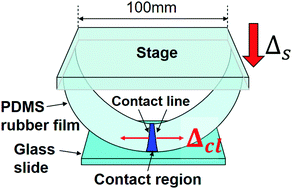Wetting dynamics of viscoelastic solid films
Abstract
We study the wetting phenomena of a soft viscoelastic solid film on a smooth and flat substrate. A poly-dimethylsiloxane (PDMS) rubber film is suspended from a stage at both ends, and the wetting behavior of the film against a glass substrate is observed while lowering the stage at a constant velocity. We find that the dynamics of the rubber–glass–air contact lines vary with the lowering velocity of the stage. When the stage velocity is sufficiently low, the film wets the substrate smoothly and the contact lines are straight throughout. Consequently, the contact line velocity is proportional to the lowering velocity. As the stage velocity is increased, the contact line velocity reaches a maximum at the critical stage velocity and then subsequently decreases. The contact lines are wavy and sensitive to the defects above the critical velocity, resulting in the trapping of air bubbles at the interface. We reproduce the wetting behavior using a simple numerical model, assuming an upper limit for the contact line velocity. The wetting behavior observed in our experiments is attributed to the transition in the in-plane stress state from tensile to compressive along the film, leading to buckling of the film above the critical stage velocity. Our results suggest the existence and importance of the maximum wetting velocity for viscoelastic solids.



 Please wait while we load your content...
Please wait while we load your content...